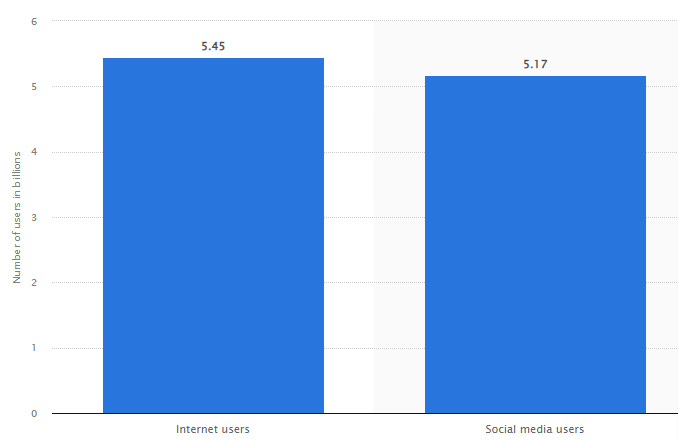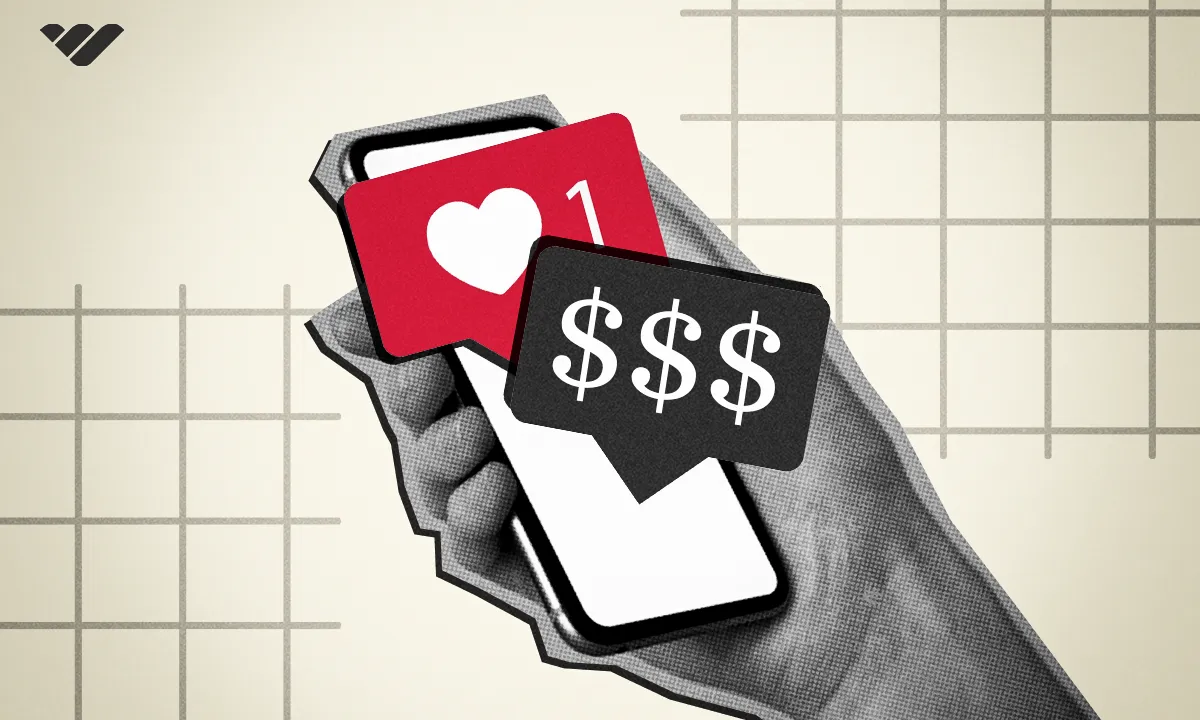Want to learn how to monetize your content? Find out in Whop’s guide to how content creators make money.
Key takeaways
- The creator economy reached $250 billion in 2025 and is expected to hit $528 billion by 2030.
- Over half of the 207 million content creators worldwide earn under $15,000 annually.
- Successful creators stack multiple monetization strategies including subscriptions, ads, and affiliate marketing.
- MrBeast remains the top-earning content creator at $85 million with 634 million total followers.
- TikTok creators earn $0.40-$1.00 per 1,000 views through the Creator Rewards Program.
The creator economy is exploding with no end in sight. In 2025, it was valued at over $250 billion. By 2030? It’s expected to hit $528 billion.
With over 207 million people worldwide creating content (and 162 million of those being in the United States), nobody is asking “Can you make money as a creator?” anymore.
Instead, the question flips to “How are creators making money right now?”
So, here’s a breakdown of the main ways creators are earning in 2026, with the most up-to-date info you need to know.
The content creator economy in 2026
Like I said, it goes without saying that you can make money creating content.
You might be worried that the market is oversaturated – but the truth is, we're consuming more content than ever. This means there's more demand and opportunity.
No shade to my own generation, but Gen-Z spends over 7 hours a day on social media – so yeah, content consumption is only growing.
In fact, pretty much everyone online consumes social content:

And it's not just social media – we found that ebook consumers, for example, will grow to 1.1+ billion by 2027.
How many content creators are monetizing their content?
I mentioned 207 million people consider themselves content creators – but the truth is, not all of them are actually making money.
In fact, more than half of these creators earn under $15K annually.
Why? Probably due to inexperience.
When we look at statistics of beginner creators, 59% are not monetizing their content, and 35% aren’t earning a livable income.

Don't get disheartened, though. That's why we wrote this article.
Whether you want to monetize TikTok content, a YouTube channel, a blog – whatever it is, we'll break it down for you below.
Because when you know what you're doing, you're way more likely to succeed.
How content creators make money
There’s no single way to earn as a content creator, and the most successful earners are stacking monetization strategies.
From subscriptions and ads to affiliate marketing and brand sponsorships, the opportunities are wide open.
How you can monetize usually depends on the type of content you produce:
- Text-based formats like blogs and ebooks
- Visuals like photography or design
- Multimedia such as videos, podcasts, livestreams, courses, music, and newsletters
- SaaS tools or apps
- Social content or UGC – you get the idea.
In reality, almost any form of digital content has the potential to generate revenue.
Broadly, though, monetization falls into two main categories:
1. Selling access to content
Here, audiences pay directly for what you create:
- Developing and selling an online course
- Writing and self-publishing ebooks
- Running a membership site or subscription model
- Offering a freemium site with a mix of free and gated premium content
2. Selling access to an audience
Instead of paying for the content itself, brands pay to reach the audience you’ve built. This can look like:
- Affiliate marketing, where you earn a commission on referred sales
- Brand sponsorships and influencer partnerships
- Revenue-sharing deals with platforms
- Placing ads within your content
To leverage these methods best, creators should learn to build a personal brand, or influence.
How do content creators become influencers?
The key difference between a creator and an influencer? Influence itself.
Anyone can post online (and still make money), but influencers build enough authority in their niche that their recommendations directly shape purchasing decisions.
Transitioning into an influencer requires a little more than creating content — it’s about cultivating a loyal following, engaging with your community, and forging partnerships with brands.
People Khaby Lame illustrate the potential: his collaboration with Hugo Boss has reportedly earned him up to $750,000 per sponsored post. Insane.

But influence doesn’t only come with massive followings. Nano-influencers (under 1,000 followers) through to mega-influencers (over a million) all have value depending on their audience engagement and niche.
In fact, studies actually show smaller influencers can hold more influence – we found nano influencers actually have the highest engagement rates.
So it's not so much about the number of followers as your personal relationship to them.
The best ways to sell and monetize content
There are heaps of ways to monetize content, but as I said earlier, the richest creators leverage a variety of platforms to monetize their content.
Here are the main places where you can profit from what you create:
Content monetization platforms
These are tools built for creators to earn from their work.
Some focus on a single format (like courses or podcasts), while others cover multiple. (Hey.)
Platforms usually take a fee or percentage of your earnings, but they handle payments and admin, so you can focus on creating.
All-in-one platforms like Whop let you sell everything from courses and ebooks to memberships and digital downloads in one place. They act as your storefront and central hub for building a creator business.
P.S. We just went independent with our payments, giving you lower fees and more ways to earn globally.
If you're looking to stack digital products and online offers, we make it easy to start selling and earning, with 24/7 support and a dedicated marketplace of buyers.
Blogs and websites
Owning your own site is actually still a profitable income stream – if you do it right.
Blogs and niche websites can earn through:
- Affiliate marketing (commissions on products you recommend)
- Sponsored content from brands
- Ad space through networks like Google AdSense
- Digital product sales like ebooks or templates
Having your own blog or website also gives you more control than relying solely on social media. Costs to run them can be hefty, though, so that's a consideration.
You can use free platforms like Whop to run blog-like posts through the Forums app, and sell other digital products like ebooks or newsletter access alongside.
Tipping/rewards
Fans love ways to support their favourite creators directly, and it's probably one of the easiest ways to be rewarded for your content itself.
Platforms like Buy Me a Coffee or Throne let audiences tip or send gifts, while Whop includes tipping features directly in your storefront.
Built-in social media monetization
Social media remains one of the fastest paths to monetization. Each platform has its own tools, requirements, upsides, and quirks.
Let’s look at the big three:
Earning on TikTok
TikTok is all about short videos that grab attention fast. With over 1 billion monthly active users, it’s a top platform to grow an audience (and earn from your content).
There are a few native ways to make money on TikTok:
TikTok Creator Rewards Program
The Creator Rewards Program replaced the old TikTok Creator Fund in December 2023.
- Requirements: 18+, in a supported country, around 10,000 followers, and 100,000 video views in the last 30 days. Only personal accounts qualify.
- Earnings: Most creators make $0.40-$1.00 per 1,000 views, but high-retention content can earn up to $6 per 1,000 views.
TikTok Pulse
Pulse is TikTok’s ad revenue-sharing program.
- Requirements: Creators with 100,000+ followers are eligible for TikTok Pulse.
- Earnings: Creators can earn 50% of revenue from ads placed next to their videos.
TikTok LIVE Gifts
Audiences can send Gifts during TikTok live streams. These convert to cash once you reach $100, with TikTok taking a 50% cut. Some non-live videos can also receive Gifts.
Pro tip: TikTok earnings vary a lot, especially for smaller creators.
Most creators earn modest amounts at first, so it’s smart to diversify across platforms and monetization types.
Making money on Instagram
Instagram monetization opportunities have expanded a lot in the last couple of years, giving creators more flexibility.
Instagram Creator Marketplace
The Creator Marketplace connects creators with brands for sponsored content opportunities. It’s available in multiple countries, including the U.S., UK, Canada, and Australia.
- Requirements: 18+, professional Instagram account, must follow Instagram’s branded content policies, and meet engagement/following thresholds (varies by region).
- Earnings: Payments are negotiated with brands and depend on factors like follower count, engagement rate, and campaign scope. Payouts can range from a few hundred dollars for smaller creators to thousands for mid-tier and large creators.
Live badges
Live Badges let fans support creators during live broadcasts by purchasing badges that appear on-screen as hearts.
- Requirements: 18+, professional account, 10,000+ followers, in an eligible country.
- Earnings: Badges cost $0.99, $1.99, or $4.99; creators get paid once they reach $100. Instagram takes a cut of payouts.
Paid subscriptions
Subscriptions let creators offer exclusive content to followers for a monthly fee.
- Requirements: 18+, professional account, 10,000+ followers, in an eligible country.
- Earnings: Subscription prices range $0.99-$99.99 per month; payouts start at $25.
Pro tip: Instagram monetization works best when you mix multiple methods: brand partnerships, subscriptions, badges, and affiliate campaigns.
That way, income isn’t tied to a single revenue stream.
Monetizing YouTube content
YouTube has over 2.5 billion users, and a load of monetization streams to help creators successfully profit from their content, long and short-form.
YouTube Partner Program
The YouTube Partner Program (YPP) enables creators to monetize their content through ads, memberships, and more.
- Requirements: 18+, 1,000+ subscribers, 4,000 valid public watch hours in the last 12 months, or 10 million valid public Shorts views in the last 90 days; comply with YouTube's policies.
- Earnings: Average RPM (Revenue Per Mille) ranges from $1 to $5; top creators in high-paying niches can earn up to $10 or more per 1,000 views.
YouTube Channel memberships
YouTube lets creators offer exclusive content and perks to fans who pay a monthly subscription.
- Requirements: 18+, YPP member, channel not made for kids.
- Earnings: Creators set their own price ($4.99–$49.99 per month), YouTube takes 30%; actual earnings depend on subscriber count.
YouTube Shopping & affiliate marketing
Creators can tag products in videos or link to affiliate products in descriptions.
- Requirements: 18+, YPP member, 10,000+ subscribers for Shopping (affiliate eligibility depends on program).
- Earnings: Commissions vary (usually 5–15% per sale for affiliate links); YouTube takes no extra cut for most affiliate programs.
Read more:
The average earnings of a content creator
How much money can you actually make as a content creator? Well, it varies a lot. Some people make a ton, others only a little.
But let's look at the top earners quickly, for a little #inspo:
- MrBeast (Jimmy Donaldson): Still the biggest earner in the world. $85M, 634M total followers, known for YouTube stunts, Feastables, MrBeast Burger, and Amazon Prime show Beast Games. Dude is just unstoppable.
- Dhar Mann: $56M, 137M total followers, owner of Dhar Mann Studios and produces viral YouTube shows with brand partnerships. While his shows used to get ripped on, they clearly worked.
- Jake Paul: $50M, 79M total followers, earns from boxing events, Netflix streaming, and HBO reality series Paul American. Love or hate him, dude has game.
- Rhett & Link: $36M, 33.8M total followers, hosts of Good Mythical Morning, run streaming channels, live events, and published a cookbook. These guys have been going for ages, and they're still top of their game.
- Alex Cooper: $32M, 15M total followers, podcast Call Her Daddy, SiriusXM deal, and Unwell Hydration drink line.
- Charli D’Amelio: $23.5M, 216M total followers, TikTok star, Broadway debut in & Juliet, partnerships with Prada, Kate Spade, and D’Amelio Brands.
So yeah, the top creators pull in eye-watering sums. But for (most) people starting, you won’t see numbers like that.
In reality, content creation income is usually much more modest – but still profitable if you treat it like a business.
These figures reflect the current average earnings across various creator tiers and monetization strategies:
- TikTokkers: Approximately $44,250 per year
- YouTubers: Around $62,400 annually
- Instagrammers: Estimated at $81,700 per year
- U.S.-based creators: Between $49K and $79K annually.
The best thing about being a content creator is that average revenue has grown loads, even in the last year. The sky’s the limit.
You can focus on one thing and blow it up or continually pivot and keep your audience guessing.
The most important thing is to build your brand and create content that people find valuable.
5 tips for making money as a content creator
If you want to make money from content creation, there's no reason not to. With so many opportunities, you'll be able to find a few that work for you.
And if you really want to boost your earnings, make sure you think about:
- How often you post
- Content type and platform
- Size of your audience
- Routes to monetization
Here are a few tips to make it easier to start earning faster from content, helping you get past that $15K barrier so many creators find themselves stuck at.
1. Choose your niche
Spend time figuring out a niche where you can create content people actually care about.
Think about your skills, interests, past content, gaps in the market, and what kind of content you enjoy making. Love cooking and reality TV? Combine the two into a fun TikTok series.
Once you’ve got a niche, check out what other creators are doing and figure out where you fit. Building connections early helps, too.
2. Figure out what makes you different
The content space is crowded, so figure out what makes you different.
Your goal is to create content that’s engaging, exciting, or just plain unique. That uniqueness is what will help you attract an audience and start making money.
3. Post the right content on the right platforms
Different platforms work better for different types of content.
Maybe you’re great at short-form video but not long-form blogs, or maybe courses are your thing. Look at what’s already working in your niche and find the platforms where you can shine.
4. Get creative with monetization
I gotta keep driving this point home, guys: there’s no one way to make money.
A popular course could lead to a podcast, which could lead to brand partnerships. Think of each piece of content as a way to open more money-making opportunities. Successful creators keep experimenting to maximize revenue.
The highest-earning creators (looking at you, Jimmy) are continually looking for ways to monetize their content, squeezing the most value out of everything they produce and keeping that flow of money coming.
5. Be consistent in your posting
Consistency matters.
At first, post often to grow your audience. Later, focus on keeping them engaged.
Frequency depends on the platform: three to five Instagram posts per week is solid, and one YouTube video per week works for many creators.
Quality always beats quantity.
Read more:
Monetize your content with Whop
If you're aiming to turn your content into income, Whop can help you succeed.
Attract your audience, grow your brand, and monetize your content all in one place.
Sell directly to your audience through your Whop page or list your offerings on Whop’s expanding marketplace, where people can discover your videos, courses, newsletters, ebooks, podcasts, Discord communities, apps, and more.
Our promise? To streamline the process by handling day-to-day tasks like payment processing, marketing, and customer management, allowing you to focus on creating.
Sign up for free and start monetizing your content smarter, not harder.



